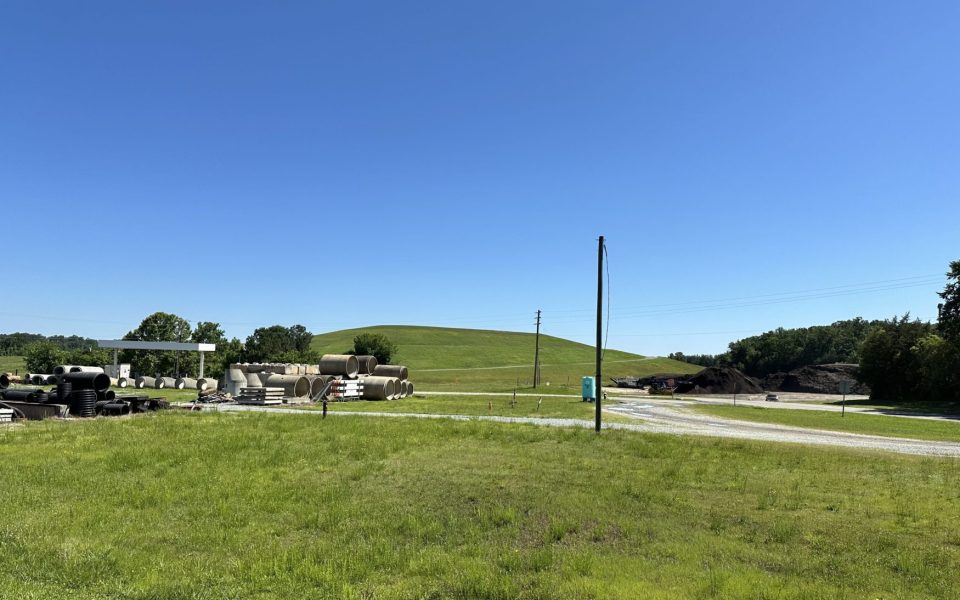Featured photo: A view from inside White Street Landfill (Photo by Gale Melcher)
(UPDATE 6/25/24: The city is inviting residents to tour White Street Landfill on July 2, 3, 5 and 8 at 2 p.m. and 6 p.m. Register here.)
East Greensboro’s White Street Landfill doesn’t quite fit the description of a landfill. It’s not teeming with refuse or the pungent smells that typically accompany sites of waste. Rather, picture lush verdant hills rolling across the skyline.
It wasn’t always that way.
Underneath those hills lie a “waste lasagna,” a term coined by the city’s Environmental Compliance Support Manager Richard Lovett while leading a bus tour across the landfill.
White Street Landfill closed to household waste nearly two decades ago, currently accepting construction debris and yard waste.
Last week, the city offered residents an opportunity to ride around the landfill in an attempt to improve public perception of their plan to use the location as a landing site for waste from Bingham Park, a 12-acre park about six miles away. The park is the site of a pre-regulatory landfill that operated between the 1920s-50s that took in household waste from Guilford County and the US Military. In 2017, NC Newsline reported that there are 677 pre-regulatory landfills across North Carolina, most of which contain “mystery substances.”
But the plan to move toxic waste from one Black neighborhood to another has some residents concerned, and reflects the city’s history of environmental racism.

The plan as it stands
Landfill standards were set in the 1980s, but before that could happen, the city decided to cover up the landfill in the 1970s and turn it into what is now known as Bingham Park. In 2010, North Carolina Department of Environmental Quality designated the site as an inactive hazardous waste/pre-regulatory landfill, and the site was finally closed to the public this April due to visitors’ potential exposure to arsenic, iron, manganese, lead, and “semi-volatile organic compounds.”
City documents state that out of the three options for Bingham Park waste disposal, White Street landfill is the “most feasible option” when compared to Uwharrie Landfill in Troy or Great Oak Landfill in Asheboro — where the city currently sends household waste.
If White Street Landfill is selected to host Bingham Park’s waste, dump trucks will travel along 16th Street or Cone Boulevard and down the Ralph C. Johnson Way connector to the Nealtown Road entrance into the landfill.
As the tour bus grumbled down the road on Friday morning, Lovett noted that there will be a delayed start to workdays in order to avoid creating unnecessary traffic.
White Street is the cheapest option, an 11-mile round trip with a cost of $24-27 million, would last four months and release 233 metric tons of carbon dioxide into the atmosphere. Compare that to Uwharrie’s 120-mile round trip with a $54 million price tag and 16-month schedule.
So far the city only has between $14.7-$22.1 million in federal and state funding for the project. Even if the city snagged the maximum amount of funding, they would still need to bring millions of dollars to the table.
“If this is truly about righting a wrong, then whatever projected shortfall should be allocated in the budget for this year,” said resident Byron Gladden, a former school board member who toured the landfill last week.
According to the city, White Street Landfill will reach capacity in the coming years. Taking Bingham Park’s waste there could accelerate the timeline of closing the landfill, shaving off eight years from its anticipated close date.

‘Another problem in a different location’
The ease of disposing of Bingham Park’s harmful waste at White Street is the very tradeoff that concerns some residents: It’s staying here in Greensboro, and it’s going to haunt a community that has suffered from the effects of the landfill for decades. The idea of taking on Bingham Park’s waste was met with displeasure by White Street residents at a May 22 town hall. By the afternoon of May 24, the city sent out a press release calling upon residents to join a tour of White Street Landfill.
White Street Landfill opened in the 1940s, and has plagued residents ever since. Two of its disposal areas are unlined — meaning that any “mystery substances” from years past had the chance to leak. However, Bingham Street’s waste would be going to White Street Landfill’s Phase III, a regulated, lined landfill. The landfill is situated in District 2, a predominantly Black district, represented by Councilmember Goldie Wells.
Studies have shown that landfills are disproportionately located in communities of color and poorer areas, with landfills being linked to higher rates of cancer. In 2011, a study by the NC Division of Public Health confirmed elevated rates of pancreatic cancer in residents around White Street Landfill.
Lovett explained some safety measures that would be taken during the work: careful monitoring, applying water to keep the dirt from Bingham Park compact on a windy day and putting a cover on the waste at the end of each workday. Still, some residents on the tour expressed concerns over the plan. One resident noted that even though the city might try to prevent errors, human beings “make mistakes.”
The resident worried that this would just place “another problem in a different location.”
Even though it’s a new era, one brimming with regulations and measures in place to help prevent injustices like Bingham Park and White Street Landfill from recurring, the community still feels distrustful of the city that has failed them for decades.
White Street Landfill is currently permitted to accept 10,000 tons of waste per day, so in order to use it as the dumping ground for Bingham Park’s waste — a 280,000 ton estimate — the city council will have to amend the permit.

On May 22, resident Lewis Brandon said that in the 67 years he’s lived in the city, changes in the community are a result of “lawsuits and demonstrations,” not because it’s the “moral thing to do.”
“You should not put this burden on White Street, and you should not put this burden on any other community,” Brandon remarked.
Gladden owned a house in the Nealtown Road area in the past and advocated to keep the landfill closed. Gladden said that touring the landfill last week helped him “see how those actions and that advocacy manifested.”
But did the tour change Gladden’s mind?
“It didn’t,” he responded.
And while the Bingham area is getting a new park, Gladden wondered: What is White Street getting other than tons of dirt? Gladden said that he’s “unsure in [his] support for the project without a strategic plan for the landfill.”
“I haven’t seen the commitment to the community around the landfill,” he said.
On June 12, the city will host a community update meeting at 6 p.m. at Peeler Recreation Center located at 1300 Sykes Ave. to continue discussing the possibility of using White Street Landfill as the disposal area.
All CityBeat reporting content is made possible by a grant from the NC Local News Lab Fund, available to republish for free by any news outlet who cares to use it. Learn More ↗
Republish this storyJoin the First Amendment Society, a membership that goes directly to funding TCB‘s newsroom.
We believe that reporting can save the world.
The TCB First Amendment Society recognizes the vital role of a free, unfettered press with a bundling of local experiences designed to build community, and unique engagements with our newsroom that will help you understand, and shape, local journalism’s critical role in uplifting the people in our cities.
All revenue goes directly into the newsroom as reporters’ salaries and freelance commissions.


The Environmental Protection Agency has stated that barriers in lined landfills “will ultimately fail” and sites remain threats for “thousands of years.”
EPA draft guidance for evaluating the need for additional post-closure care begins a discussion of the “Criteria to consider for extending or shortening the post-closure care period,” and the “Nature of hazardous wastes remaining in the unit.”
The draft reads: “Presence of hazardous waste: Because many hazardous wastes degrade slowly or do not degrade under containment in these units, the continued presence of hazardous waste in the unit (i.e., any case other than clean closure) indicates the potential for unacceptable impacts on human health and the environment in the future if post-closure care is not maintained, and suggests that post-closure care should be extended, even if there is no current evidence of actual releases from the facility.”
https://www.gfredlee.com/Landfills/USEPA_PostClosure_Period_Adj_Com.pdf
Additionally: “At best, Subtitle D landfills that are sited, designed, operated, closed, and receive postclosure care following the standard minimum practice prescribed by Subtitle D will only provide temporary containment of waste-derived chemicals that are a threat to groundwater quality and the public health and welfare of those who own or use properties near the landfill. This reality continues to spawn justified NIMBY positions among those who live, work, or use property near Subtitle D landfills; it also speaks to the overall adequacy of the “responsiveness to public attitude.” The long-term consequences of the “modern” Subtitle D landfilling are borne largely by those within the sphere of influence of the landfill, who are typically people in less populated areas. Waste generators in more heavily populated areas enjoy the disappearance of their MSW (i.e., waste “management) for cheaper-than-real costs as the public health and welfare costs of the “management” of their wastes are borne by those in the landfill area.”
https://www.gfredlee.com/Landfills/Expectations_Perf_SubtitleD.pdf
In the above article, Mr. Brandon states, “You should not put this burden on White Street, and you should not put this burden on any other community.”
So then, the question becomes, why should a community in an entirely different county be the one who has to deal with a problem that was started in Greensboro decades ago? Greensboro and Guilford County need to deal with their own problems somehow, and not think they can keep pushing other nearby counties around to deal with their messes.